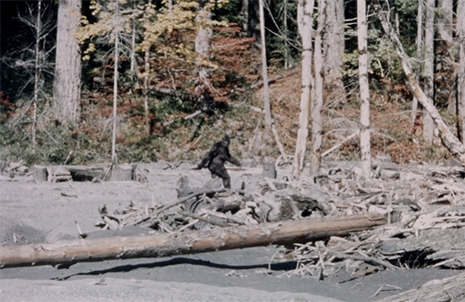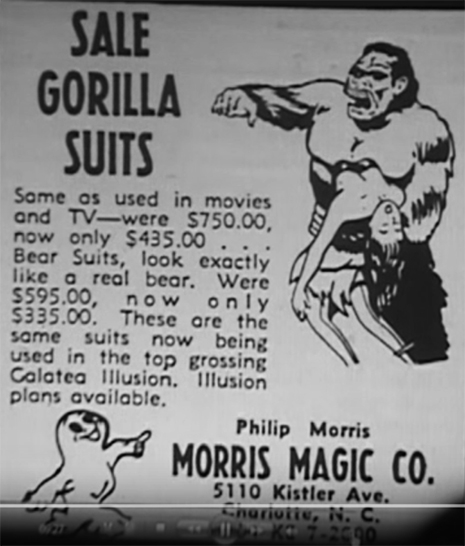
Recently I saw a social media post touting a newly “stabilized” version of the infamous 1967 “Patterson-Gimlin film” of “Bigfoot.” I was astounded to find that this footage, which I assumed everyone knew had been debunked, was still making the rounds for folks wanting to believe.
Is it just that the debunking stories don’t get told as often because they aren’t nearly as interesting as the prospect of a seven-foot-tall hominid cryptid skulking the woods of Northern California having been caught on (excessively shaky, out-of-focus) film, or is it simply that there are still so many people willing to believe—even in the face of credible sources explaining their role in the fakery?
Wikipedia indicates that there are at least seven scientists who have conducted studies favorable to the Patterson-Gimlin film being legit. One wonders if these might be the same seven scientists denying global warming.
A few years back I attended a lecture by the man who claims to have produced the actual suit worn in the film. He tells a compelling story.
79-year-old Philip Morris of Charlotte, North Carolina is a magician and entrepreneur who began a costume and stage prop business in the early ‘60s, Morris Costumes, which has grown to become one of the largest costume companies in the country. In the 1960s, Morris Costumes was one of the few companies producing gorilla suits for magicians and carnivals. Morris claims that in 1967 a man called him, identifying himself as Roger Patterson, stating that he was a rodeo cowboy wanting to buy a gorilla suit for a “gag.”

According to Morris, Patterson swindled money out of investors to raise the money for the (relatively expensive for the time) $435 suit. Morris claims that Patterson promised seven different investors a 50% cut of the profits for a “Bigfoot film” he was going to produce (do the math). Through these “investors,” Patterson was able to send Morris a money order for the gorilla suit.
“I didn’t think it was a real big deal,” said Morris. “It was just another sale.”
Morris shipped the suit to Patterson.
Patterson later called Morris back asking how to make the suit more “realistic.” “He asked me to send him some extra fur and asked how to hide the zipper in the back and how to make the person in the costume look larger,” Morris said. “I told him to brush the fur over the zipper and use hair spray to hold it, and then get some football shoulder pads and sticks for the arms to give the illusion of being taller, and use stuffing to get more bulk.” And that was the last Morris heard from Patterson.
_465_655_int.jpg)
In October of 1967 Morris saw the famous footage on television and recognized his suit. “I was watching TV when I saw Patterson and his film on the news,” Morris said. “I called my wife from the other room and said, ‘Look it’s our gorilla costume.’”
Morris indicates that he didn’t initially go public with the information about the sale of the suit because he didn’t want to expose a fellow illusionist, stating: “In my mind it was a magic trick.”
He didn’t want to break the magician’s code.
Morris didn’t start speaking publicly about the suit until Patterson died in 1972. Even then, he mostly told his story at trade conventions.
Eventually, Morris’ story made its way to Bigfoot researcher Greg Long.
Greg Long’s The Making of Bigfoot: The Inside Story devotes an entire chapter to Morris’ claim that he provided the costume for Patterson. “I couldn’t see any motive beyond that he wanted to tell the truth,” Long said. “This was just a good story that he decided to tell.”
“Most people believe me, but there are people that are very hostile to me when I tell them it is a hoax,” Morris said. “It is like telling them Santa Claus doesn’t exist. They grew up believing it was true and do not want to admit to themselves it’s fake.”
His story seems believable, but can Morris really prove that he sold a suit to Patterson which was used to fake 59.5 seconds of jerky out-of-focus “Bigfoot” footage? I suppose not, but then again, I want to believe.
Here’s Philip Morris talking about the sale of the suit to Patterson:
And here’s the original Patterson-Gimlin film:
Previously on Dangerous Minds:
South Carolina woman reports sighting of ‘Lizard Man,’ captures photo evidence